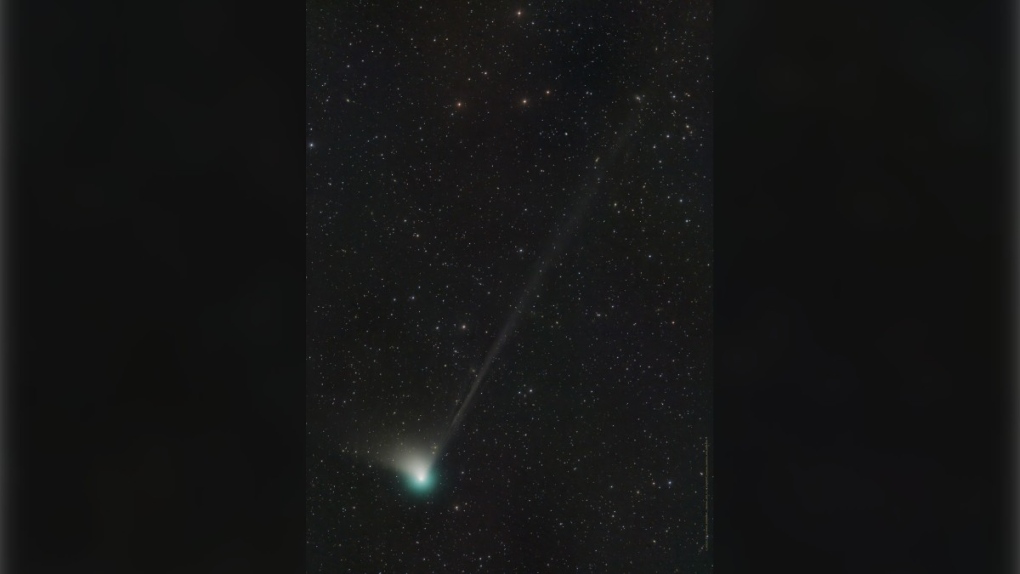Western University to host viewing party for once in a lifetime phenomenon
 Comet C/2022 E3 will reach its closest point to Earth on Feb. 1, 2022. (Dan Bartlett/NASA)
Comet C/2022 E3 will reach its closest point to Earth on Feb. 1, 2022. (Dan Bartlett/NASA)
It may be green in appearance but it isn’t envy that gives this comet its unique colour.
“Comets are usually white or blue. This one has a different colour,” says Paul Wiegert, professor of astronomy at Western University. “It's caused by a molecule which doesn't exist here really on earth. It's called dicarbon, but it can exist out in space. And some comets produce a lot of dicarbon and have this green colour and others don't.”
This comet was discovered in March 2022, and while it orbits the sun like earth, it takes thousands of years to make a single pass.
Comets like this may have been responsible for delivering water to early earth, and contain important clues about the chemistry of star and planet birth, Wiegert explains.
“We sometimes say that it's like a chocolate cake. There's a lot of ingredients that went into this chocolate cake. But the earth doesn't look very much like its ingredients anymore in the same way that a chocolate cake doesn't look like eggs or flour or sugar or anything like that.”
While the comet will be visible with the use of binoculars or small telescopes next week, Western’s Hume Croyn Memorial Observatory is holding a free open house Saturday, Jan. 28 that will reveal a much better image as long as the clouds stay away.
“If the weather does cooperate and we don't have too many clouds, we'll be pointing some telescopes at this comet. Fingers crossed that we get good weather,” says Wiegert
The comet will be most visible on Feb. 1, but will still be visible in the days before and after that point if clouds are persistent.
CTVNews.ca Top Stories

Air traveller complaints to Canadian Transportation Agency hit new high
The Canadian Transportation Agency has hit a record high of more than 71,000 complaints in a backlog. The quasi-judicial regulator and tribunal tasked with settling disputes between customers and the airlines says the backlog is growing because the number of incoming complaints keeps increasing.
LIVE @ 1:15 PT B.C. premier to give announcement related to public drug use
B.C.'s premier is scheduled to give an update Friday about public drug use in the province.
Orca calf that was trapped in B.C. lagoon for weeks swims free
An orca whale calf that has been stranded in a B.C. lagoon for weeks after her pregnant mother died swam out on her own early Friday morning.
AFN chief says Air Canada offered a 15% discount after her headdress was mishandled
After the Assembly of First Nations' national chief complained to Air Canada about how staffers treated her and her ceremonial headdress on a flight this week, she says the airline responded by offering a 15 per cent discount on her next flight.
Sophie Gregoire Trudeau on navigating post-political life, co-parenting and freedom
Sophie Gregoire Trudeau says there is 'still so much love' between her and Prime Minister Justin Trudeau, as they navigate their post-separation relationship co-parenting their three children.
U.S. flight attendant indicted in attempt to record teen girl in airplane bathroom
An American Airlines flight attendant was indicted Thursday after authorities said he tried to secretly record video of a 14-year-old girl using an airplane bathroom last September.
76ers All-Star centre Joel Embiid says he has Bell's palsy
Philadelphia 76ers All-Star centre Joel Embiid has been diagnosed with Bell’s palsy, a form of facial paralysis he says has affected him since before the play-in tournament.
DEVELOPING Bird flu outbreaks: WHO weighs in on public health risk
The current overall public health risk posed by the H5N1 bird flu virus is low, the World Health Organization said on Friday, but urged countries to stay alert for cases of animal-to-human transmission.
Island near Mull of Kintyre for sale for US$3.1 million
An idyllic 453-acre private island is up for sale off the west coast of Scotland and it comes with sandy beaches, puffins galore, seven houses, a pub, a helipad and a flock of black-faced sheep.

































